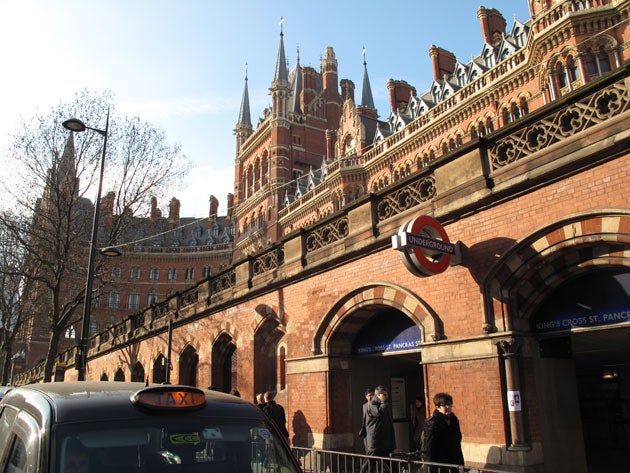A Renaissance arrives at St Pancras

One shortcoming prevents St Pancras station living up to the title of the Roman martyr, Pancras, whose name means "one that holds everything": presently there is nowhere to sleep. There is a youth hostel, but only on the far side of Euston Road, the clogged six-lane superhighway that separates the station from central London. But 30 days from now – and 75 years after it closed its doors to the travelling public – the former Midland Grand Hotel is reborn, appropriately, as the St Pancras Renaissance.
The spectacular façade of the hotel has decorated the north-eastern corner of central London since 1873. Gilbert Scott's Midland Grand comprised an Imperial palace planted in a gloomy patch of the capital. How obsessive was the architect? Well, he insisted that every window had a unique surround.
As a building, it was a magnificent celebration of the height of Victorian power and ambition; as a hotel, it was financially disastrous, and lasted barely 60 years. The palace was taken over by railway offices. Scott's legacy was squandered, and the role of St Pancras in the national network was eroded to a terminus serving places that few people wanted to visit, such as Luton, Kettering and Loughborough.
During the architectural barbarism of the 1960s, the station and hotel only narrowly avoided demolition thanks to a campaign led by Sir John Betjeman. The poet laureate's statue stands on the station concourse, just beyond the booking office – a space that sums up the miraculous rebirth of St Pancras.
While successive generations of politicians puzzled about what to do with the building, nary a lick of paint was wasted on St Pancras. As it turns out, that was the hotel's saving grace. The ecclesiastical panelling in the booking office has been painstakingly protected during the refurbishment. From next month, the staff will dish up steak-frites for diners, rather than selling Savers to Sheffield to harried travellers.
The Booking Office Bar and Restaurant is adjacent to the new hotel foyer, which has been built over the former taxi rank. Look north from here, and you can see the joins: most of the 245 bedrooms are in a newly built extension, Barlow House, welded to the side of St Pancras station.
All the attention, though, will fall upon the High Victorian Gothic flourishes in the original building – starting with the parts of a hotel that are rarely discussed in print: the corridors, and the staircases.
The main east-west corridor stretches the full width of the facade, and is far wider than modern hotels. The reason: it was built to allow two ladies wearing expansive Victorian skirts to pass each other without incident.
One of those women may have been making for the Ladies' Smoking Room, the first public venue in London where they could consume tobacco. Today, smoking is banned – but the chamber, with a 22ft ceiling that is the standard gauge here, feels as though a fragment of Versailles has drifted across to London NW1.
The feature that will take your breath away, though, is the grand staircase. Here, Scott took railway architecture to its glorious conclusion, with a stairway that soars heavenward, lifting the spirits as easily as it does the eye. Everything from the carpet to the gold-on-maroon fleur-de-lis wallpaper has been faithfully reproduced to thrill, and much original art remains.
And the 38 "Victorian bedroom suites"? As far as it is possible to get from the sterility of standardisation. English Heritage has watched the rebirth like a hawk, insisting that original features are preserved. That presents challenges, especially on the bathroom front. In 1873, en suite was unknown. As a result, awkward, dark-panelled units have had to be shoehorned into spaces designed for a different era. But aesthetic compromise is the price of a power shower – and essential if the £150m investment by the developer, Harry Handelsman, is to pay off.
Other five-star hotels are available in London, most of them in more prepossessing locations than opposite Burger King on the A501. The market will decide whether a starting price of £300 (excluding breakfast) can be sustained, but the nation should celebrate the rescued legacy of Gilbert Scott. The architect even gets a new Marcus Wareing restaurant named after him. And if you feel like catching a train, set your sights beyond Beds. The departure boards at St Pancras, the greatest cathedral of the railway era, now include the cities of Canterbury, Lincoln, Paris, Brussels and Avignon. A miracle, indeed.
St Pancras Renaissance hotel, 020-7841 3540; stpancrasrenaissance.com
Join our commenting forum
Join thought-provoking conversations, follow other Independent readers and see their replies
Comments
Bookmark popover
Removed from bookmarks